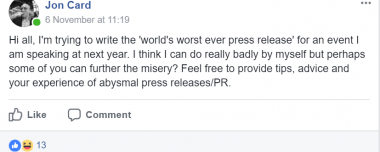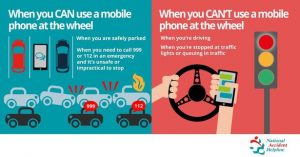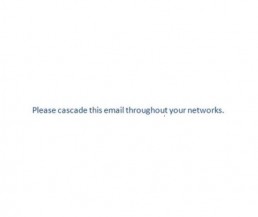How to get press as a small business

It's hard to get heard, when you're only small.
Big businesses can afford to be loud, and they often spend thousands, if not MILLIONS, getting the right kind of attention from the press. But small businesses need press and links just as much, and are sometimes more deserving of attention.
They just need to find ways to be heard.
To correct the balance between big businesses and small ones, we need SMEs to have the confidence, and ability, to shine, in the face of what can seem like overwhelming competition.
Luckily, while smaller organisations don’t have the same budgets, they do have some advantages, which we can use to propel them into the limelight. Where big brands usually win on budgets, they often lose on agility and the willingness to experiment.
- Startups have a natural passion, which makes them authentic
- A small, new brand doesn’t have a big audience, and there’s less to lose, which reduces the fear of failure that can slow bigger businesses down
- For startups, there isn’t a gap between ideas and launch – and ideas don’t get watered down due to risk
But there’s still a big knowledge gap between small companies and their rivals – the PR agencies that work for big companies.
But one principle which can help small businesses compete, comes from psychology. Social psychologist Adam Galinsky points out the importance of perspective taking: looking at the world through the eyes of another person. Galinsky explains that perspective taking expands your range of acceptable behaviour, and increases your power. He says:
"When I take your perspective, and I think about what you really want, you're more likely to give me what I really want."
And, when we take someone's perspective, it allows us to be ambitious and assertive, but still be likeable. All very useful for a small company that needs confidence in the face of big business competition.
And what do other people want, that can lead to you getting great PRESS? Well, journalists want articles which are newsworthy, suitable for their readership, and, in many cases, ready to publish. Consumers often want to see their own work, and personal stories, championed in the press. And everyone wants to be told they’ve done a good job.
If you can use the narrative, expertise and resources available to you through your business, to give others what they really want, you’ll be able to get the press that your company deserves. But how can you give them these things? I’m going to give you some tools which will help you use perspective-taking to give you the confidence and insights to earn press and links, without the need for a big business budget.
FOCUS ON PHOTOS
One thing that journalists really want, and that many marketers forget, is photos. Pictures can determine story selection and dictate the media agenda. And there are a number of ways small businesses can use them to get press. So, get a photoshoot. Your company, itself, has a story, or a number of stories, which will be interesting to the press. But a photoshoot will help you to tell, and to sell, those stories.
Get some photos of your founders, which help to illustrate who they are and what they do. These will be invaluable for getting them press for years to come.
And, get users to provide you with high quality images. We’ve run user generated content campaigns that have gained press and links from countless news publications, radio sites, councils and colleges. One campaign, that got a link from the BBC, involved someone who won a selfie competition, with a selfie taken on top of a mountain.
We found the right person to contact in the BBC – someone who was based in the area of the competition winner. We took their perspective, as someone who wanted articles suited to their readership. We also took the perspective of the competition winner, who submitted his photo because he was, rightly, proud of his own work, and wanted to share it.
Also, if you sell tangible products, get high quality photos of these. And, if they’re things which could conceivably be gifts, make sure you have photos of them taken with a white or transparent background. Because everyone: news, magazines and blogs, loves to publish gift guides. There are hundreds of them.
And, if you can offer a simple image of your product on a white or transparent background, there will be hundreds of opportunities for you to place this in major titles, and relevant blogs, to get amazing inbound links, press and sales.
USE RESPONSE SOURCE
Journalists often need an expert opinion on a particular topic. In many cases, as a small company, you can be the expert, by helping a journalist who’s perspective you’ve learned. And to do this, you can use a service called ‘Response Source.’ It’s a service I would recommend every small business invests in. Journalists use the platform to send out queries about articles they’re writing, which PR people or businesses can respond to, and get press and links in the process.
You can choose relevant categories and take a free trial. With that trial, you can see where journalists are looking for expert opinions, articles and images which you’re able to provide. And you need to become an expert at responding quickly and effectively. Taking the journalist’s perspective and providing them with EXACTLY what they want.
But there’s another important point about perspective taking, and that’s thinking about the moment the journalist has sent out a request. At that moment, they don’t know if they’ll get one reply, or hundreds. So, if you can be first, and reply within the hour, with exactly what they want, you have a much higher chance of getting noticed, and getting press. A couple of days later, when they already have a hundred responses, you might be too late.
But also consider, from their perspective, they need to be able to justify why they’ve chosen YOU to quote as the expert. So give them an interesting, relevant quote, and give them, and their readers, reasons to believe you’re the expert. Mention well-known clients, awards and any other notable achievements, in brief, when you introduce yourself, and in a way that can be published directly ahead of the quote you’ve provided.
PREDICT THE FUTURE
But sometimes, you’ll want to be PROACTIVE in getting press, working out for yourself what journalists will want and when, and providing them with just the right content at just the right time, purely from your own work, imagination and hypothesising about the future.
Many sites will show you upcoming events and awareness days, so you can work out when to target journalists with relevant content, tailored to their publication. But a good way to get ahead of the competition is to have the confidence and wiliness to research and target the things other people might NOT have spotted. To do this, you need to know the press around your industry, and the press around your consumers’ needs and interests, inside out. So; read, read, read.
Have the confidence to get in touch with authorities to strengthen your content, and always take their perspective, as well as the perspective of the public. By taking other people’s perspective at every stage, you can gain TRUST with authorities, and TRUST with the public. And, In the long term, TRUST leads to people engaging with your brand, over others. But journalists will need more than just trust in order to use your content. You need to get everything ready for them in a way that they can use it.
WRITE THE NEWS
This includes writing a press release effectively. The first thing you need is a story. If you want it to be published by news sites, it has to be news.
It needs to have a hook that makes it new. News stories work well if there’s an element of SURPRISE, if it’s something people care about, if there are fresh, verifiable stats and if there’s a news peg – something BIG, that’s already happened, and that your news story relates to.
When you’re writing the release, it should be written just like news. That means, write to the standard ‘inverted pyramid’, eliminate jargon and sales pitches, get straight to the point and write in the third person, so it’s all ready to publish. And it makes sense to aim for an inbound link, both for traffic and for SEO. But, for a journalist to include a link, it’s not enough that you want one in there, because they’ll need something called ‘editorial justification’.
They need to be able to justify the link from the perspective of their typical reader. So, provide something useful on your site that’s not available in the release, or give the reader something to DO there, like enter a competition or register for something they’ll value.
DIGITAL PR IS POSSIBLE FOR SMEs
Ultimately, to do effective digital PR, you need confidence in your product, and you need confidence in your abilities. Make sure you’re passionate about what you’re marketing, take other people’s perspectives, follow these steps and you’ll be able to make any company famous.
130 Ways to Annoy a Journalist
We recently asked a group of journalists if PR people had ever annoyed them with their press releases.
It wasn’t hard to get them talking.
Complex attachments requiring passwords, a lack of usable photos and faux-caring enquiries into a writer’s health and / or well-being were all sure to get on their nerves. But if you’re guilty of these heinous misdeeds, fear not: most journalists receive so many emails that they’re unlikely to remember it was you, and most marketers [myself included - CC] have committed at least one of these crimes. So - let's just all remember for next time, ok?
In the name of education, as well as comedy value, we’ve listed a selection of our journalist panel's answers below. Read on for our top 130 ways to annoy a journalist - we think you'll find them amusing and cringe-worthy in equal measure.
-
Make a tenuous connection to a news story. Royal wedding happening? This is a great opportunity to try and get coverage for a cordless drill!
-
Be sure to include some form of excitement about it being Friday / the weekend, despite the fact that most journalists work at weekends. And sign off with a kiss. ['FriYAY!' *Bangs head against desk.*]
-
I love nothing better than a cheesy line about enjoying the sunshine in the email when I have been on deadline and have barely seen daylight all week
-
Follow up with hourly phone calls - specifically aiming for periods when huge global stories are breaking
-
Call frequently, ideally as soon as the release has been sent, asking for coverage and, if not, WHY NOT?
-
Write URGENT in the subject line for a press release about something that is happening in a month's time
-
Fill it with meaningless jargon about key performance indicators and leverage
-
"To: C-list editors" in the subject line. I had that once
-
EXCLUSIVE in the subject line, with everybody listed who's getting it
-
Ones with subject titles IN ALL CAPS are reliably rubbish
-
Once had a press release about an album whose predecessor apparently "literally flew off the shelves"
-
First line: "Three years ago..." For a release about a band. I nearly replied with a definition of 'news'
-
Describe something as "with a difference", "reimagined", "unique" or "with a twist"
-
Oh! 'Engagement', and 'reach out', without the context of; shiny, sparkly ring signifying betrothing, and song by The Four Tops
-
'Content/content providing.' *hands get a bit fisty.*
-
Had one recently which claimed to actually alter the fabric of time!
-
Misspell the product/service in a few places, so it's not clear which is the correct spelling
-
"Please do hesitate to contact me with any questions" was a sign-off that got my attention - briefly
-
Send it the day after an important date: 'Amazing Looks for Halloween!' (on November 1st). And then send it again a week later
-
Send me a long and detailed pitch for a feature idea THAT IS IN MY CURRENT EDITION. And refer to the interviewee as a 'bran manager', This happened today in the same pitch email
-
"No, we can't send you a review sample because they're all out with our community of Instagram influencers."
-
Weird Capitalisation and a Reluctance to Send pictures or Media until After emBargo
-
Remember To Use Lots Of Random Initial Capitals especially in People's Titles. Makes it look more important, some PRs seem to think
-
Ensure you're promoting a company with a stupidly rendered name like ORGan'iq.
-
Make sure to start it with: Dear <insert name here>
-
Don't tell them what the release is actually about until at least the third paragraph
-
"Nice to e-meet you" is always a nice touch. [cringe]
-
Geographical irrelevance, eg sending it to a York paper when the subject matter is based several hours away
-
Assume everyone is in London, always. I particularly enjoyed this when the word 'Scotsman' was in the email address they'd sent it to
-
Send at least three times just to make sure they got it and to see if they are interested in following up...
-
Don't forget to include the fact that every email sent with a press release needs to open with "Hope your well?"
-
Try inserting some spurious connection to location and / or celebrity e.g "Fred, who went to school with the drummer from local band Firestix..."
-
I had one last week where the email began 'Dear Sirs'.
-
Don’t bother breaking the copy into easily scannable paragraphs or bullet points
-
Include the words cutting edge, innovative, disruptive and solution. Also - be sure to have a quote that says how excited and proud the person is to be launching the new product. If it is launching it IS new - that one used to really grind my gears
-
Be sure not to show any understanding of my publication or readership or what we write about. And make me email you for high-res pics instead of putting a link in the press release
-
Start "Dear <name>". Start the subject line with "Re:" so it's obvious it's a re-sent test email
-
Have a 152 word opening sentence (true story). Finish with "If you're not the right person in your organisation, please forward"
-
"Link to images attached. Get in touch for password"
-
Whatever you do, do not include any photos - I mean, who needs photos available 24 hours a day when writing to a deadline?
-
Talk about franchises, annual turnover, vertical markets and generally big up your company in the first three paragraphs. Then send it to consumer press
-
DEFINITELY WRITE THE SUBJECT LINE IN ALL CAPS
-
Don't bother with any contact details at the end
-
"I'm not sure if you read my previous 27 emails..."
-
Attach an out-of-focus, low-res photo
-
Oh yes, do please ring me at lunchtime to make sure I got your press release about something that is not at all suitable for my readers, I love that
-
Ensure that any quotes are clunky and unnatural, the kind of thing nobody would ever actually say out loud
-
Here are the contact details for the expert we've quoted but haven't warned her about this press release so she'll be delighted to hear from hundreds of you and won't be free to talk until 2019
-
Don't forget to invite the journalists to events that have absolutely nothing to do with their publications. I'm getting endless press releases about food packaging summits in Ireland. I'm a tech hack, and I work in Devon
-
Start the subject line with 'RE:' to make it look like you're responding to an earlier message from me. Drives me crazy!
-
Bonus points for a Z-list celeb endorsing technology they don't understand, and double bonus points if said technology is blockchain
-
Use plenty of clichés, and as many adjectives as you can fit in
-
Send it to completely the wrong area...so an event in Newcastle-upon-Tyne sent to a journalist in Newcastle-under-Lyme.... this happens A LOT
-
Neon is the new black. Sex is the new black. Mindfulness is the new black. Velvet is the new black. Saying anything is the new black is, apparently, the new black. Arrrggghhhh!
-
Vegan. Oh god. Vegan
-
Make sure to send it only as an attachment, Also, include: "if this should be directed to someone else at your publication, please send me their names and contact details." (This is so fun!)
-
Put an EMBARGO on it with the date of two days' previously
-
Invite me to an event that happened last night (this has happened). [Even worse, send a release telling you how wonderful was the event to which you weren't invited.]
-
Attach a word document with small, low res photos embedded into it, saying "I've attached some great images for you to use"
-
Invite the press to a launch. What it is you're launching is currently TBA, but, "Take my word for it, it's exciting. Do you want to come?”
-
Put "Press Release" in the subject line of the email. Just "Press Release". I have a nemesis PR who keeps doing this. [To be fair, if all PRs put the phrase ‘Press Release’ in the subject, it would be so much easier to organise mass ‘search and delete’ sprees...]
-
Only offer an interview with someone with no real authority in the organisation. Someone like the new deputy cloakroom manager.
-
"WHY don't you want to talk about the importance of physical activity with an Olympic gold medalist?" "One, the aforementioned Olympian is from Nova Scotia and I'm in Quebec, and two, our piece is about physical education and immigrant youth, not about your silly project, so we'd really rather have a few immigrant teenagers and a high school gym teacher, thanks."
-
Use a really tiny font and no paragraphs [Yes. Really tiny ‘fun’ handwriting font...] [Comic sans! And clip art!]
-
Include a WeTransfer link that expires five minutes after the press release is sent. [At least once a week I find a way to lose at WeTransfer.]
-
Use tonnes of business talk. Gentle reminder, leveraging etc.
-
Oh don’t forget the all-important spurious ‘survey’ with only seven ‘respondents’...crucial!
-
The PR who tries to personalise the email, but asks if you would like to attend an event on behalf of a competitor title
-
Addressed to you by name in the address bar, then, Dear Editor, or addressed to ‘Melissa’ and then, formally, ‘Dear Sir’
-
Send me a low res image of a product with no price, no clickable link, no stockist info. Or send me a long blurb about a fancy pants new hotel with no address details in the email or even on the site
-
Make it at least 10 pages long with several thousands of words, ensuring that all the sentences make absolutely no sense at all. word soup
-
Lots and lots of jargon - and acronyms / initialisations without explanation
-
Mention some posh celeb event or party you weren't invited to the day after the event in the hope you'll still write about it or plug that your product, e.g. jewellery, was sported by a celeb at said event and likewise
-
Open your e mail with "Hi there! Hope you are feeling well/great" when you've never previously had any contact or know them
-
Oh yeah, don't forget to put every recipient's email address in the to field, thus gaining bonus points for a notifiable data breach
-
Go full BUZZWORD BINGO! Creative storytelling, influencers, no budget, exposure, Fab! AMAZING, followers, pop up, rooftop, vintage - because people have *just* discovered this new thing called vintage, pop up and rooftop. It's in Shoreditch/Hackney. Crowbar in 'Street food'
-
Don't forget to include incredibly basic yet chronic grammatical and spelling errors. [As in: "the new way to loose weight"]
-
And just in case the press release IS useful, make me go through a 24-hour registration process to access your free marketing images. I'll definitely want to wait a whole day for you to notify me that you've accepted the 13-page password-protected registration form I filled out
-
Always misuse the word "iconic". [And see if you can't misuse the word 'ironic' in the same sentence - just for fun.] [Also 'legend/legendary']
-
Make the language as obscure as possible, bury the one interesting fact in the very last paragraph
-
When you are told by the journalist that they could possibly use the release but have an idea for a different angle, be sure to be chronically unhelpful, and try to steer the journalist towards the angle of the press release because clearly you know what a publication needs much better than the editor of said publication. [Yep, implicitly criticize our editorial judgment. Nothing we enjoy more.] [The sheer arrogance and ingratitude of it all!]
-
Use emoticons [And #hashtags and excessive exclamation marks!!!]
-
Don't forget to include the thrilling enticement of presenter/Love island/former lad rag model 'DJing' at said event! [And by 'DJing' that's posing by CDJs with premixed CD, while staring at their phone, and only coming to life if someone asks for a selfie.']
-
"Please cascade this email throughout your networks". Genuine PR thing
-
Don't include a real person's contact details and make sure any image links are for super lo-res pics [And make it a locked pdf file.]
-
On a related note, send print journalists information about your Christmas range of goods and services, so they can put them in their Christmas features. Send this on the first week in December, as there’s no point annoying them with it earlier, and obviously, print magazines won’t even have started their Christmas issues, three bloody weeks before Christmas
-
The worst kind is the one that tries to be topical on the back of bad news
-
I know a PR who addresses every email in block capitals, and occasionally bits of the press releases too. That's always fun
-
And start your covering email, "Hi X, I hope you're really well?" Health PRs in particular seem to be a very sickly lot. My health is fine, thanks
-
Be sure to include some junk science, especially if it's about detoxing or preventing cancer
-
"New and innovative / tailored and bespoke" [I'm reaching out to you..because]
-
Don't attach any photos. Not even tiny ones in portrait orientation
-
Attach it as a Word document, especially a docx that you can't open with an old version of Office
-
Attach lots of irrelevant documents and pictures that I have to sift through to find the correct one
-
Fill the intro with important stakeholder name-checks, but don't actually explain what the release is about. Use the phrase "in partnership with"
-
Precede all quotes with reported speech in which the speaker is invariably "thrilled" or "delighted"
-
Bury a really good story in the last paragraph
-
End all quotes with an exclamation mark (or, worse, several)
-
Use regional surveys attributed to a specific location. "80% of people in Dewsbury eat Baked Beans every day", but actually it's 4 people from a sample of 5 in the whole of Yorkshire
-
Have no concept of geography outside London. "Liverpool is in the north, right? So you'll be interested in this event in Sunderland?"
-
Send a press release about Bury St Edmunds to someone in Bury, Lancashire
-
Use lots of industry-specific jargon
-
Provide a case study, but with no basic information about the person, such as their age, job, or where they live
-
Give obviously made-up quotes that simply repeat facts from the release and do not express any opinion
-
Provide quotes that are full of brand names and only praise the thing being promoted
-
Describe awards as "like the Oscars of the basket-weaving industry", or whatever shite it is your company does
-
Write 1,000 words about the fact your assistant chief operating officer has been promoted to senior partner
-
Ask for a link to your client's website to be inserted into a story, especially phrased as a demand for a correction
-
Quote people with really long job titles, capitalised. Dave Smith, Head of External Customer Relations and Partnerships EMEA at Spafftech Inc, said: "I'm thrilled... etc"
-
When you send the email, write: "Hey there, just thought I'd reach out to you/touch base about bla bla bla..." and continue to include as much jargon/marketing lingo as you can, something that every journalist hates. Oh and then threaten to call said journalist. That ought to bring on a few heart palpitations
-
Ask me to send you a cutting
-
Worst ever - attach the document as an image so you can't copy anything into an editable format
-
Don't forget to get ridiculously huffy if you're asked for the dataset behind your hideous and terrible infographic or your ludicrously bad report based on half a dozen responses to a SurveyMonkey quiz. [I get so much joy from press releases based on pathetic survey methodology. All the joy!]
-
If you're lucky enough to get any response from the journo, and they tell you: 'Thanks, but no' to your press release, advise that you call them to argue the toss and tell them why what they're turning down is such a GREAT story...
-
"Delighted to announce." / “Offering you a great opportunity...”
-
I particularly love turning up to an interview I've agreed to do having been told all sorts of stuff about what useful things I'm going to hear as we talk specifically about the piece I'm writing, only to find that the interviewee hasn't been briefed and is expecting a few softball Hello-style questions about his (it's always his) amazing, lifechanging, revolutionary, disruptive, brilliant start-up
-
Maximise the number of wanky marketing references that describe sweet FA. Remember to leave your reader wondering what you were trying to promote/why you just wasted two minutes of your time you'll never. get. back.
-
Just remembered another one - "can I offer you this ready-made feature?" both doing me out of a job and not bothering to check whether I am a commissioning editor at the moment
-
When I worked on video games magazines, we loved it when a PR called to say, "I'd like to place an article in your magazine." We'd direct them to the advertising department, and then have to explain why
-
'Curated'
-
Don't forget Wackaging, and ghastly puns
-
Once you've sent it, don't forget to chase just a couple of hours later. Just in case your contacts aren't simply sitting there WAITING for this one release to land
-
If music, ensure use of "sophomore" and "drops" instead of "is released" plus do not forget to attach a 9.99999999Mb picture which when the email finally downloads is revealed to be 99% meaningless shadows and textures. [And make sure to mention the group are the "The next xxxx", even if they sound nothing like them [memories of Coldplay being launched as the next Radiohead!] [Remember that singles aren't 'released' in 2017. They 'IMPACT'.]
-
Begins: "Hey mate, I just wanted to reach out…" [*hands get a bit fisty.*] [Oh there's an extra bit of spice to that one.... "Hey mate, HOPE YOUR WELL? Just wanted to reach out..."] [Just wanted to reach out and touch base."]
-
How would you like to write about this amazing event we didn’t invite you to? [Or "exclusive", five-star holiday resort, arriving by private plane and with personal chef. Just recommend it to readers, please, though you won't have visited.] ['Free drinks'! = Rubbish beer/wine which you need tokens for]
-
Ones that don't include basic stuff like RRPs for products, contact numbers, websites etc...
-
Pepper it with spelling errors and typos (especially in people's names) and omit apostrophes entirely. Don't include a link to the client's website
-
One that asks "Could you just pop a little news story up about this product that is totally irrelevant to your beat and has nothing remotely newsworthy about it"
-
Irritating follow-up emails should you be daft enough to open their original gushing email. Then the tone changes to almost hurt that you've not been in touch since you were "so interested" in the latest launch of a new type of toilet roll
-
“Please check your spam folder" ho ho ho
Writing 'the world's worst ever press release'
I am attempting to write the world's worst ever press release.
It's for an event I'm currently working on where I'll be teaching business owners how to communicate effectively with the media.

I thought an example demonstrating all of the things not to do would be an amusing way to get started.
So then I thought that a little crowdsourcing might help me. After all, if I'm going to create a true monstrosity - the sort of thing that will leave my fellow journalists writhing in agony, literally convulsing at their desks - some input from my colleagues seemed like a sensible idea.
I belong to a Facebook group where journalists offer help and advice to one another, and also complain about all the people who've upset them recently - may their ears burn.
I posted the following:

Within 48 hours, my post had gained over 200 responses. Fueled by a mixture of fury and glee, journalists offered a seemingly endless number of ways to really screw up a press release.
The group is closed, so I won't be publishing the posts directly. Also, the bilious hatred expressed by some members of the group towards certain practices of the PR industry could, all too easily, be taken out of context.
However, here are five of the best ways to really antagonise a journalist, in case you ever need to.
Incorrect names
Journalists take a dim view of emails where their names are spelt incorrectly, are addressed 'dear sir' (especially women) or messages that begin with [insert name here]. Cheery chit chat about the weather and signing off with xx also grates.
PointLess caPitalisation
The tendency for some in the PR industry to capitalise words that neither start sentences or are proper nouns draws much criticism. They don't much like exclamation marks, either.
PDFs
Press releases sent as attachments draw much ire. However, none more than the dreaded PDF which, for many journalists, has come to stand for: 'Please Do F***-off.
Burying the story
It would seem journalists like to be able to discern a tale early on, rather than several paragraphs in.
Marketing speak
Telling a journalist about your "bespoke, highly tailored, innovative solution" can lead to twitchiness.
Jon Card will be offering training sessions to businesses this year to help them get press, see upcoming events here.
Five things to consider before sending a press release
Journalists both hate and rely upon press releases, but they delete more than they ever use. Here are five questions communications teams should ask before hitting the send button.
Why are you writing this?
I often wonder why people send press releases. Were they written to please a client? Did their boss tell them to do it without explaining why? If this is the case, you’re wasting your time. The only good reason to write a press release is because you want a journalist to write a story. Fix your attentions on the job the journalist is doing.
Is there a story there?
In one sentence, say what the story is and ask yourself this question: will anyone care? Would you tell your partner about it? Or your friends in the pub? If not, then why would a journalist care or, more to the point, their readers?
Can it be read very quickly?
Journalists received countless emails every day, mainly from people working in the PR and communications industry. You should assume that whatever you send them will be read very quickly. Therefore, a press release needs to make impact right from the top; the headline and first few paragraphs are of crucial importance.
Does the headline make sense?
You don't need a Sun-style pun headline, just a short, sharp sentence that describes what the story is about. You need to be sure that the majority of people actually understand all of the words in that headline. It is common for journalists to receive press releases filled with industry jargon and acronyms – journalists might not understand these and, if they don’t, their audiences won’t, either. A good headline encapsulates what the story is actually about and contains some excitement and interest.
Are the quotes human?
Salesy quotes are a press release killer and lead to many deletions. Convince your chief executive to say something interesting. Give a point of view. Make an observation. But don’t try to sell your product, or it won’t get published.
Jon Card is a freelance business journalist who writes regularly for The Guardian, The Times and Telegraph. He will be appearing at the next Coverage Class: How to Write a Press Release
How to tailor a press release for different audiences
If you have a news story to share on behalf of your company, you’ll want as many relevant audiences as possible to see that story. Here’s how you can work out who those audiences are and tailor your press release to appeal to each of them.
Work out your audiences

If you’re sharing a story about your company, think about which audiences might be interested in that story. To do this, consider the ‘angles’ your story could take, based on the key elements of what you’re sharing. For example, if your company has developed a new app for cyclists, the story may well, of course, be interesting to the cyclists who could use it.
But there are a range of other groups you can target to extend the reach of your story.
Technology enthusiasts might be interested in how your app was developed. Those interested more generally in fitness and well-being might like to know how the app can help improve their training and exercise regimes. Perhaps there’s a way the app can help parents teach their children or teenagers more about their cycling.
Consider all the possible benefits and uses of the information and then, which audiences could be interested in those.
List the publications you want to target
Once you have a list of potential audiences, you’ll need to build lists of which publications cater to those audiences. The longer the lists, the better.
Don’t stick with the biggest publications, either – if you can find smaller, more niche publications, you may be more likely to get your story published by them as they’ll be receiving fewer press releases each day. Create themed lists based on audiences with similar interests.
Tailor your press release for each audience
Having listed out your themed publications, you’ll be able to more clearly who your main audiences are. With each of those audiences in mind, amend your original press release to appeal to them specifically. This will involve making tweaks to the headline as well as the information you share.
If you’re targeting parents, include a quote which relates to them, and include any relevant data you can find, showing how your news could affect parents.
It’s worth spending time and energy at this stage as, the more relevant the story becomes to each of your target audiences, the better.
Write bespoke emails
When reaching out to journalists and site owners, make your email as tailored and unique as possible. Ensure the subject line gives a clear indication of the relevance to their readers.
Include the name or names of the people you’re emailing. Unless you've invested in distribution software, this will mean sending out emails one at a time, rather than en masse. Also include a short intro outlining how they might be able to use the story, based on the particular publication they run.
Also bear in mind the tone and structure of a typical article from each publication, and aim to mimic this when you send them your release.
The more clear it is that you’ve sent as story for their readership, which is written for a particular purpose, such as a news feed item or blog post, the more likely they are to use it.
Four digital PR campaign ideas that will gain coverage, links and engagement
Coming up with new ideas for digital PR campaigns can seem like a mind-boggling task. How do I create something that other people will really want to share, engage with and link to online?
These four fail-safe digital PR ideas are an excellent starting point for any successful campaign.
1. Make important information easier to digest
When the penalty for using a mobile phone while driving increased in 2017, government advice on when it was legal or illegal to use your phone while driving was available, but the details came across as dry and hard to remember. Working with a designer, we created an image for a client which made this information a lot easier to digest. This digital PR campaign generated 37 pieces of authoritative news coverage, including an article published by ITV.

2. Identify upcoming events and prepare relevant content
In the example above, it was vital to have the infographic ready to share with journalists, immediately before the law was updated. This meant having the foresight to ask the DfT when exactly the law was going to change, and planning far enough ahead to have everything signed off and ready to go in advance of that date. A simpler version of this process is using an awareness day calendar to prepare relevant content for specific, predictable events. Look for awareness days which are somehow relevant to your company so the campaign makes sense for readers. Other predictable events you can build digital PR campaigns around include seasonal changes and national holidays.
3. Carry out surveys or collect and share data from your own company
One of the best ways to generate a good, shareable headline is with fresh data. If you have the budget, commission a full survey on a topic which is a. relevant to your company and b. trending or otherwise of interest to people. Even better if you can get hold of statistically significant, regional data and generate an online, interactive map. If you're on a strict budget, cheap ways to carry out a survey include promoted Twitter polls and one question Google Surveys. Another cheap way to get hold of headline-grabbing data is to use information your company already has access to. For example, perhaps there was an increase in specific types of enquiries following Brexit, or your customers began buying a particular product during a heatwave. If you're able to put a fresh perspective on something that's relatable to the general public, journalists will be interested.
4. National competitions
Branded competitions are a genius way to get media coverage for your business. While journalists can be reluctant to put a brand in the spotlight for its own sake, they're much more happy to share news of a local person who's won an award or is shortlisted in a national competition. Photo competitions can work particularly well for digital PR campaigns, as journalists are always keen to use great images to illustrate a story. Remember to share shortlisted entries while the competition is still running, and to include a link back to an onsite entry form - we've generated hundreds of authoritative links and pieces of coverage this way.
How to create win-win relationships with journalists

Journalists can come across as abrupt, or even rude, to PR people and companies seeking publicity for their campaigns. Often, a business will take a huge amount of time and effort to put together a pitch, only to receive a 'no thanks', or even no response at all, from the journalist.
Here's what many of these companies don't realise:
- Journalists are receiving huge numbers of pitches. Sometimes these can amount to hundreds, even thousands of pitches every day, almost none of which are usable for their publications
- In an era where newspapers are often down to skeleton staff, but still have the same amount of space to fill, most journalists are under huge pressure to hit deadlines in a short space of time
The flip side to this situation is that, where a company can actually make a journalist's life easier, the business will reap rewards, with great coverage and ongoing, win-win relationships. But how can companies achieve this?
Here are five ways to improve your relationships with journalists:
- Think of a strong news angle and make that angle clear from the start. If the main point of your story is hidden half way down the email, it doesn't matter how good that angle is, the journalist will never see it. They'll be put off immediately off by the weak headline
- Write your press release in the third person. This will make it easier for a journalist to use your story as it will have been written in the way it needs to be published
- Remove anything obviously promotional from your pitches. Your press release and other media needs to come across as designed for the benefit of the publication's readers, or journalists will instantly press 'delete'
- Include quotes. A story without direct quotes lacks substance, so make sure you've included at least one quote from a person who can speak authoritatively about the story you're telling
- Include high quality imagery with your pitch. Pictures can make or break a story and, for print, journalists can scale those photos up or down. This means they can easily use exactly the right amount of space
If you'd like to learn more about how to deal with journalists, sign up for one of our upcoming Coverage Class events.
Five reasons to create content beyond your business
I recently wrote an article for award-winning digital marketing agency atom42 on five reasons you should create content beyond the immediate scope of your business. I think it's a great idea to do this - the five reasons I list are:
1. YOU’LL REACH A BIGGER AUDIENCE
2. YOU’LL GENERATE OPPORTUNITIES FOR CONSUMER INTERACTION
3. YOU’RE MORE LIKELY TO GET LINKS
4. YOU’LL CREATE BRAND AFFINITY
5. YOU’LL STAY INTERESTED
You can read the full story here.
Do you create content for your business? Do you have a content strategy which helps you decide what to write? let us know!











